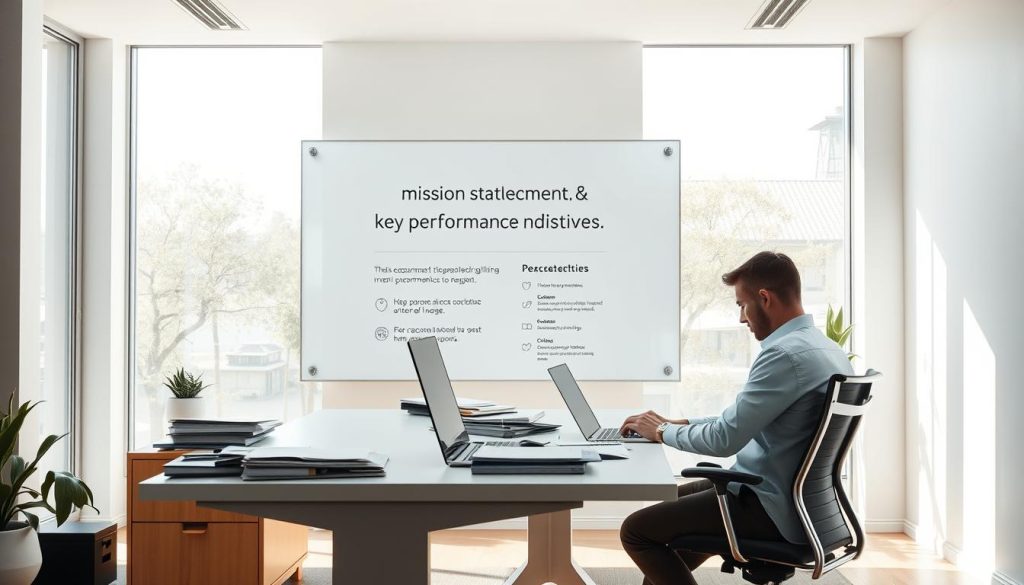Accountability means owning actions and outcomes. In fast-paced teams, this clarity raises productivity, sharpens priorities, and helps people deliver consistently. A healthy culture makes feedback normal and lets employees learn from mistakes without fear.
Gallup finds only 30% of employees say their managers involve them in goals, and just 2 in 10 strongly agree managers motivate them. That gap drains engagement and slows performance.
This short, practical guide will show how clear goals, steady communication, and light-weight check-ins help teams and managers close support gaps. You’ll get definitions, day-to-day behaviors, real-world examples from product engineering and customer support, and quick wins to try now. Shift the mindset: accountability is not blame. It is clarity, growth, and better solutions that lift everyone in the work environment.
Table of Contents
Key Takeaways
- Owning outcomes improves team focus and work delivery.
- Clear goals and feedback boost employee engagement.
- Managers who model transparency raise performance.
- Light check-ins and progress tracking yield fast wins.
- A learning culture turns missteps into improvements.
Why Accountability Drives Productivity in Today’s Workplace
Embedding clear goals, timely feedback, and steady tracking changes how a team performs. When people know expectations and who owns what, they stop guessing and start delivering. Betterworks shows engagement and productivity rise when these elements are built into everyday routines.

Connecting accountability to engagement, morale, and results
Clear goals and open communication align members around what matters. That alignment lifts performance and reduces rework. Leaders who model transparency create a culture where employees feel safe to learn from mistakes.
Closing the gap: What employees need from managers right now
Gallup data reveals a shortfall: many employees are not involved in goal setting and rarely feel motivated by their manager. Teams need fair evaluation, regular feedback, and prompt support from leadership.
- Quick wins: co-create one team goal this week, set success metrics, and add a five-minute feedback round to your next meeting.
- For more on improving engagement, see employee satisfaction strategies.
What Job Accountability Means and How It Shows Up Day to Day
Accountability is owning both the actions and the outcome. It means agreeing on timelines, sharing progress, and being honest when results shift.

From ownership of actions to outcomes
Responsibility often names who does a task. Accountability focuses on whether the work achieves the agreed outcome.
Clear expectations and time-bound milestones make success visible. This reduces rework and helps employees plan deep work.
Proactive behaviors vs. reactive habits
- Set timelines, confirm expectations, and document decisions without prompting.
- Raise risks early, propose solutions, and ask for help before problems escalate.
- Prep meetings with data, double-check metrics, and record handoffs to avoid ambiguity.
Mindset matters: treat mistakes as learning steps, not personal failures. One committed team member can model consistent follow-through and lift the whole workplace.
Try a weekly self-check: outcomes delivered, risks spotted, support needed, next week’s priorities with timelines. For more on practical follow-through, see job fulfillment.
The Benefits of Accountability at Work for Teams and Performance
Teams that agree on who does what spend meetings solving problems, not rehashing confusion. Clear ownership builds trust and transparency between employees and management. That trust lets teams focus on progress and blockers during team meetings.

Trust, transparency, and better team meetings
When roles and outcomes are visible, meetings shrink and become action-oriented. Teams track milestones, highlight risks early, and leave with clear next steps.
Higher employee engagement and job satisfaction
Employees feel more autonomy when expectations are clear. That ownership increases employee engagement and raises job satisfaction because contributions tie to outcomes, not just effort.
Faster problem-solving and reduced conflicts
Accountable teams surface risks sooner and resolve blockers faster. Clear roles cut overlapping work and ease handoffs across cross-functional teams. The result: fewer conflicts and shorter cycle times between milestones.
- Measured gains: less rework and faster delivery.
- Culture shift: learning over blame improves communication and collaboration.
- Small wins: try starting meetings with a quick wins-and-blockers round to reinforce growth.
Leaders should model transparency by sharing what went well and what will change next sprint. For practical tactics that strengthen managerial skills and support this change, see strategies for managerial development.
Proven Strategies to Strengthen Job Accountability
Practical routines and clear metrics turn intentions into reliable outcomes for teams. Use a mix of goals, feedback, and simple tools so members know what success looks like and how to get there.

Set clear expectations with SMART goals
Use SMART goals so employees know what they’ll be judged on and why it matters. Share context: priorities, trade-offs, and how success will be measured over time.
Give evaluational feedback and constructive criticism
Evaluational feedback compares output to expectations and speeds improvement. Pair it with specific, actionable constructive criticism that points to solutions, not blame.
Run regular check-ins
Recommend weekly or biweekly check-ins to review tasks, unblock work, and align owners before deadlines slip. Keep notes in a shared dashboard or Slack thread.
Provide resources and support
Leaders should ensure resources—training, playbooks, mentorship, and mediation guides—are available so members can deliver. HR tools can help managers structure check-ins and track progress in the flow of work.
Recognize accountable behaviors
Public recognition in team channels or all-hands reinforces a culture where follow-through and transparency matter. Small wins build momentum and encourage growth.
- Set a 24-hour turnaround for routine questions.
- Keep a shared risk log updated before each check-in.
- Follow up on outcomes, not just effort: agree owners, milestones, and next steps.
Quick template: Objective, owner, measures, timeline, resources, risks, next check-in.
For tactical career steps that align with these practices, see career advancement tips.
Real-World Examples: Demonstrate Accountability Across Roles
Concrete scenarios across roles make it easy to see which behaviors produce reliable outcomes. Below are short, practical examples that teams can apply today.
Leaders and managers
Leaders model responsibility by owning outcomes, clarifying priorities, and inviting two-way feedback that turns issues into actions.
Remote team members
Remote members keep lines of communication open, set personal deadlines, and ask for help early. Simple rituals—daily standups and a visible backlog—make time and dependencies clear.
Customer-facing roles
In support, an accountable rep investigates a complex complaint, consults colleagues, tests fixes, and provides an interim workaround while a permanent solution is built.
Product teams
Product and engineering teams split tasks, check in frequently, and surface dependencies. Leaders recognize wins publicly and add support where needed to keep momentum.
- Write down owners for each task and agree on review dates.
- Document decisions and follow-ups so actions are trackable.
- Use short demos and standups to catch issues early and share solutions.
These examples scale across functions—from sales to engineering—because the principles are universal. For ways to improve wider team satisfaction, see improve satisfaction.
Make Accountability Visible: Goals, Data, and Recognition
Tracking goals in the flow of work makes performance a shared, actionable conversation. Use visible goals and live metrics so progress is clear to everyone, not locked in separate spreadsheets.
Align goals and track progress in the flow of work
Align goals to strategy and track them where work happens—dashboards, task boards, or your team space. This keeps expectations clear and reduces handoff friction.
Use performance data to spot strengths and gaps fairly
Managers should use data to compare outcomes with clear expectations. Train managers to interpret metrics, reduce bias, and give specific feedback that points to improvement.
Celebrate wins publicly to build a culture of accountability
Call out concrete behaviors and outcomes in team meetings. Public recognition builds trust, boosts morale, and helps employees see what success looks like.
- Give employees visibility into metrics, milestones, and blockers before reviews.
- Run monthly review sessions to discuss opportunities and allocate resources.
- Confirm next actions, owners, and dates in writing after each review.
For practical guidance on fair leadership and workplace ethics, see workplace ethics.
Conclusion
Simple rituals — clear goals, quick check-ins, visible metrics — change how teams deliver results.
Accountability cultures encourage trust, fair feedback, and ongoing learning. When employees take ownership and leadership gives clarity, resources, and recognition, the team resolves issues faster and lifts performance.
Try a quick plan this week: define one SMART goal, schedule a recurring check-in, and pick two visible metrics to track progress. Document the owner, tasks, and next date in a shared space.
Keep feedback specific and timely so improvement opportunities become part of everyday work. Leaders should model responsibility and celebrate follow-through to build trust and growth.
Start small: clarify one outcome, one owner, and one date — then repeat. Momentum builds from visible, steady steps.
FAQ
What does boosting productivity through effective job accountability look like in practice?
It means clear expectations, defined timelines, and visible ownership for tasks. Teams set SMART goals, managers provide resources and regular feedback, and progress is tracked in meetings or tools. This reduces confusion, speeds decisions, and helps people focus on high-impact work.
How does accountability drive engagement and morale?
When roles and outcomes are clear, people feel trusted and valued. That trust increases motivation, improves collaboration, and raises overall satisfaction. Regular recognition and fair performance conversations deepen commitment and reduce turnover.
What do employees need most from managers to close the gap between expectations and results?
Employees need clear priorities, consistent coaching, and timely removal of obstacles. Managers should offer resources, give constructive feedback, and hold focused check-ins that solve problems rather than just review status.
How does responsibility show up day to day beyond simply completing tasks?
It appears as proactive communication, ownership of outcomes, and willingness to learn from mistakes. Team members anticipate dependencies, share context, and adjust plans when new information arrives rather than waiting for direction.
What’s the difference between proactive behaviors and reactive habits at work?
Proactive behavior means planning, anticipating risks, and proposing solutions. Reactive habits involve constant firefighting and waiting for instructions. Proactive teams reduce delays and improve quality by taking initiative early.
What tangible benefits do teams see when they strengthen accountability?
Teams experience higher trust, clearer meetings, faster problem-solving, and fewer conflicts. You’ll also see improved performance metrics, better customer outcomes, and higher employee engagement scores.
How can managers set clear expectations that actually stick?
Use SMART goals, share the broader context, and connect tasks to measurable outcomes. Repeat priorities in one-on-ones, document agreements, and confirm deadlines so everyone understands who owns what.
What’s the best way to give ongoing, evaluational feedback without demotivating people?
Focus on specific behaviors and outcomes, balance praise with areas for growth, and offer actionable next steps. Keep feedback timely, private when corrective, and tied to development opportunities to encourage improvement.
How often should teams run check-ins to track progress and unblock work?
Short weekly or biweekly check-ins work well for most teams. Daily stand-ups suit fast-paced projects. The key is consistency and using the time to remove blockers, not rehash tasks.
What resources and support are critical to sustain an accountable culture?
Training, clear processes, accessible tools, and managerial time for coaching are essential. Career development paths and psychological safety help people take responsibility without fear of blame.
How do you recognize and reinforce accountable behavior effectively?
Highlight specific examples in team meetings, link recognition to outcomes, and offer public praise or small rewards. Recognition should be timely and tied to values like reliability and solution-focus.
How can leaders model accountability in a way that changes culture?
Leaders should be transparent about their own commitments, admit mistakes, and request feedback. When managers follow through visibly, it sets a norm that others can emulate.
What practices help remote team members stay accountable?
Clear personal deadlines, asynchronous status updates, shared documentation, and regular video check-ins keep remote work aligned. Trust and explicit communication replace proximity as the coordination mechanism.
How should customer-facing staff demonstrate follow-through and learning from errors?
They should confirm commitments to customers, document outcomes, and conduct quick post-incident reviews to prevent repeats. Repairing trust promptly and sharing lessons protects relationships and reputation.
How do product teams balance shared reliance and individual responsibility?
Define component owners, set cross-functional milestones, and use retrospectives to refine workflows. Shared KPIs plus clear handoffs encourage collaboration while keeping accountability visible.
What role does performance data play in making responsibility visible?
Data highlights strengths and gaps objectively, guiding coaching and resource allocation. When metrics are fair and contextualized, they support better decisions and reduce bias in evaluations.
How can managers celebrate wins without creating competition or resentment?
Celebrate team achievements publicly, credit individual contributions privately when appropriate, and tie recognition to collaborative behaviors. Emphasize learning and collective progress over single-person heroics.
What steps should a manager take if someone repeatedly misses commitments?
Start with a candid one-on-one to understand blockers, then agree on a clear improvement plan with measurable checkpoints. Offer support like training or adjusted scope, and escalate only if there’s no progress.
How do you encourage a mindset that treats mistakes as learning opportunities?
Normalize honest post-mortems, reward transparency, and avoid punitive reactions to sincere errors. Leaders who share their own lessons create space for experimentation and faster growth.





